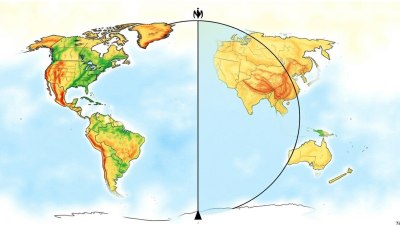How Asia’s Climate Ranges from Siberian Frostbites to Tropical Sweat Zones
Explore Asia's diverse climate, from Siberian chills to tropical heat, revealing its unique ecosystems.

Image by evening-tao on Freepik
Asia, the largest continent on Earth, is a vast landscape characterized by its rich diversity in climate and ecosystems. Spanning a multitude of latitudes, it experiences extreme variations that range from the bone-chilling frosts of Siberia to the sultry tropical sweat zones in the south. This article delves into the various climatic zones across Asia, exploring how geographical features, latitude, and altitude contribute to the continent's complex climate tapestry.
Siberian Climate
Beginning in the northernmost reaches of Asia, the Siberian climate is primarily classified as subarctic, characterized by harsh winters and short, mild summers. The region experiences some of the coldest temperatures recorded on Earth, with winter temperatures averaging between -30 to -50 degrees Celsius. The Siberian tundra, dominated by permafrost, sustains minimal vegetation including mosses, lichens, and small shrubs. The region is also home to the taiga or boreal forests, which consist primarily of coniferous trees like Siberian larch and spruce.
Winter in Siberia lasts for approximately six to eight months, with temperatures plummeting due to the region's vast landmass, which lacks mountains to trap heat. During this period, the area experiences heavy snowfall, followed by a brief but welcoming summer, where temperatures can rise to 15 to 30 degrees Celsius. This dramatic temperature shift leads to a period of rapid growth for flora and fauna after the long winter.
Continental Climate in Central Asia
Moving southward into Central Asia, we find predominantly continental climates, which feature hot summers and cold winters. Countries like Kazakhstan, Uzbekistan, and Turkmenistan are marked by stark temperature contrasts, with winter temperatures plunging to -20 degrees Celsius and summers soaring upwards of 40 degrees Celsius. Central Asia's landscape varies from the vast steppes to rugged mountain ranges, influencing local weather patterns significantly.
Precipitation in this region is somewhat limited, leading to arid conditions in many areas. The terrain is primarily made up of desert and semi-desert environments, such as the Karakum and Kyzylkum deserts. The notable Tien Shan and Pamir mountain ranges not only impact weather patterns by creating rain shadows but also provide critical water resources through glacial melt. The region's unique ecosystems support a variety of plant and animal species adapted to the extreme conditions, including hardy grasses and migratory birds.
Monsoon Climate in South Asia
As we further journey south, the climate transitions into the renowned monsoon climate of South Asia, particularly in countries like India, Pakistan, Bangladesh, and Nepal. This region experiences distinct wet and dry seasons. The monsoon season, typically from June to September, is driven by the southwest monsoon winds, which bring heavy rainfall, often exceeding 300 centimeters in some areas. The intense precipitation rejuvenates the fertile plains and vital rivers such as the Ganges and Brahmaputra, sustaining millions of people who rely on agriculture for their livelihood.
During the dry season, from October to May, temperatures can soar to above 40 degrees Celsius in some areas, particularly in the western deserts of Rajasthan. In contrast, the Himalayan region experiences cooler temperatures and heavy snowfall in winter, creating a unique microclimate suitable for diverse flora and fauna. The interplay between the Himalayas and monsoonal winds creates the dramatic variations in climate across South Asia.
Tropical Zones of Southeast Asia
In Southeast Asia, countries such as Thailand, Vietnam, Indonesia, and the Philippines showcase a tropical climate characterized by high humidity and consistent warmth throughout the year. Averaging between 25 to 35 degrees Celsius, temperatures seldom fluctuate, and the region experiences two primary seasons: the wet season and the dry season. The wet season, driven by the northeast monsoon, can bring torrential rains often leading to flooding, while the dry season is marked by sunny skies and warmer temperatures.
The rich biodiversity of Southeast Asia is a result of this tropical climate, harboring lush forests, vibrant coral reefs, and an abundance of wildlife. Rainforests in Indonesia, for instance, are among the most biodiverse in the world, supporting countless species of plants and animals, including orangutans and tigers. Sustainable management of these ecosystems is crucial, as the impacts of climate change and deforestation pose significant threats to their survival.
Subtropical and Mediterranean Climates
Some regions in Asia, particularly parts of China, the Korean Peninsula, and even sections of Japan, experience subtropical and Mediterranean climates. These regions display hot summers and mild winters, with adequate rainfall distributed throughout the year. In southern China, for instance, the climate often supports productive rice cultivation due to the warm temperatures and copious rainfall. The proximity to the ocean mitigates extreme temperatures, making these climates among the most temperate in Asia.
In contrast, the Mediterranean climates found in parts of Turkey and coastal regions of Israel exhibit hot, dry summers contrasted by wet winters. This climatic zone tends to support agriculture strongly, particularly olives, grapes, and citrus fruits, leveraging the ideal conditions for cultivation.
Arctic Climate in Northern Asia
It is essential to note that while Siberia dominates the northern climate spectrum, some parts of Northern Asia, particularly regions within the Russian Arctic, experience a polar climate characterized by long, extreme winters with permanently frozen subsoil. In these harsh climates, vegetation is scarce, consisting mainly of resilient species that can withstand the cold, including mosses and small hardy plants.
The Arctic circle influences much of the weather patterns, with continuous daylight in summer and complete darkness in winter. This unique climatic condition heavily impacts the indigenous populations such as the Yakuts and Chukchi, who have adapted their lifestyles around these extreme weather patterns. Traditional practices, including reindeer herding, continue to be a part of cultural identity amidst changing environmental conditions.
Climate Change and Its Impacts
As we navigate through Asia's diverse climate zones, it is crucial to acknowledge the impacts of climate change that challenge the region's ecosystems and communities. The increasing frequency and severity of extreme weather events, including heatwaves, droughts, and floods, pose significant threats to agriculture, biodiversity, and the livelihoods of millions. Coastal regions facing rising sea levels are particularly vulnerable, with countries like Bangladesh and the Philippines at high risk from flooding and displacement.
Efforts to combat climate change in Asia have been gaining momentum, with initiatives aimed at promoting sustainable practices, enhancing renewable energy deployment, and developing climate-resilient infrastructure. Regional cooperation is essential to address transboundary challenges, as environmental changes in one country can drastically affect its neighbors.
In summary, Asia's climate is a reflection of its extensive geographical diversity, ranging from the frigid tundras of Siberia to the balmy tropics of Southeast Asia. Each climate zone not only shapes the environment but also influences the cultures, economies, and ways of life of the people living in these regions. As we face the global challenge of climate change, understanding the intricacies of Asia’s climates and their impacts is more critical than ever.











